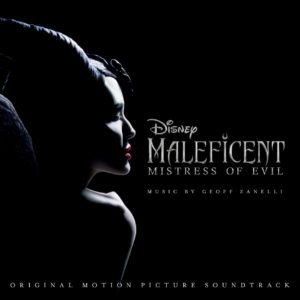
Sometimes a composer has to write music for a sequel, even though he was not the composer for the original movie. He or she can do two things when this happens. The first is to come up with something completely different. One of the most famous examples is the music Patrick Doyle has written for Harry Potter and the Goblet of Fire, which was the first Harry Potter movie not scored by John Williams. Another example is Pacific Rim: Uprising, of which you can find a review on this site. The second thing a composer can do, if he is allowed to, is reusing the music from the previous movie, while also coming up with new material, which is what composer Geoff Zanelli has done for Pirates of the Caribbean: Salazar’s Revenge. He was a logical choice for that movie because he has written additional music for this movie series since the first Pirates of the Caribbean. Disney was obviously happy with his work, because he was asked to write the music for Maleficent: Mistress of Evil, in which he reused the gorgeous themes from Maleficent, written by James Newton Howard.
For the first track of the first movie’s soundtrack, Howard wrote a suite of music from the movie. Zanelli did the same with his first track “Mistress of Evil.” At 94 seconds, his version is shorter rather short, which does not matter that much, since the music in it is gorgeous and includes some of his own themes for this movie, such as a theme that returns in “Etiquette Lessons.”
When you are talking about the music from this movie, you have to address the music from the first one. Both the Maleficent and the Aurora theme are present on this score. Aurora’s theme is simply gorgeous. Its melody is fantastic and really stands out. Examples of this theme can be heard in “What’s Going on Here,” for which Zanelli has written an amazing buildup using the melody of the theme to a glorious climax. Another example can be heard in “You Don’t Have to Change”, where a slower and more emotional version of the melody starts on one clarinet, taken over by the female choir and other instruments. Maleficent’s theme is more like a pattern of 4 notes, most of the time sung by a female choir. The most beautiful version of these notes can be heard in “The Phoenix.”
New elements are introduced for the sequel, which was an opportunity for Zanelli to come up with his own additional themes. The one I like the most is a kind of march with heavy brass sounds, battle cries in the choir and percussion, which you can hear, for example, in the second half of “Ulstead.” The four notes of the original Maleficent theme can be used to portray different emotions. In Mistress of Evil, the theme is a reflection of herself as a person. In the first movie, however, it was used a lot to highlight the evilness of Maleficent, for example, when she cursed Aurora. If you listen closely to this march, you can hear the same four notes as a foundation highlighting that evilness. Another characteristic aspect of the theme are the metallic sounds in the percussion, giving a hint of iron, which is the weakness of Maleficent’s species: the dark fey.
In contrast to hints of iron in the evil theme, the theme for the dark fey has no trace of said metal in it at all as Zanelli has stated in an interview: the theme has no instruments containing iron in it, but uses a lot of tribal instruments from all over the world, highlighting the refugee aspect of the dark fey. This theme can be heard for the first time in “We’re Dark Fey,” containing a beautiful melody and an amazing climax by the French Horns with tribal percussion as the foundation. More percussion in support of the theme can be heard in “The Dance of the Fey,” and a more emotional version of the theme can be found in “Origin Story.”
The rest of the album consists of very melodic underscore for the scenes, with hints of all the themes where they are needed to support the story. There are some melodic uplifting tracks like “Pinto’s Recon Mission,” “Hello, Beastie!” and “Time to Come Home.” In addition, the soundtrack also contains a lot of battle music as can be heard in “Your Majesty, They’re Coming from the Sea” and “Protecting Our Kind.” Like with the previous movie, this one also includes a song for the end credits called “You Can’t Stop the Girl” performed by Bebe Rexha.
I can imagine reimagining the music from another composer must be quite a challenge. Nevertheless, Geoff Zanelli has proven with the fifth Pirates of the Caribbean movie that he is able to do just that, and he has done so again for this score. Not only are the existing themes integrated very well in this score, but Zanelli’s new material is wonderful to listen to as well. I love scores with well thought out ideas and many thematic melodies, and this is an excellent example.
Listen or buy
- Buy this soundtrack digitally from Amazon.com or iTunes
- Listen to this soundtrack on Spotify
Tracklist
The highlights are in bold.
- Mistress of Evil (1:33)
- Poachers on the Moors (4:24)
- What Is Going on Here? (4:31)
- Ulstead (2:39)
- Etiquette Lessons (2:05)
- All He Wanted Was Peace (4:50)
- We Have Her (3:49)
- We’re Dark Fey (3:53)
- Pinto’s Recon Mission (1:52)
- It Is Love That Will Heal You (2:07)
- Origin Story (2:30)
- You Don’t Have to Change (2:01)
- The Dance of the Fey (2:11)
- Back to the Moors (1:14)
- Our Fight Begins Now! (1:45)
- Your Majesty, They’re Coming from the Sea (2:16)
- I’ve Made My Choice, You’ll Have to Make Yours (3:33)
- Protecting Our Kind (2:42)
- Maleficent Returns (5:09)
- The Phoenix (4:41)
- Hello, Beastie! (3:42)
- Time to Come Home (5:49)
- You Can’t Stop the Girl (performed by Bebe Rexha) (2:39)
Total length: 1 hour and 12 minutes
Walt Disney Records (2019)




